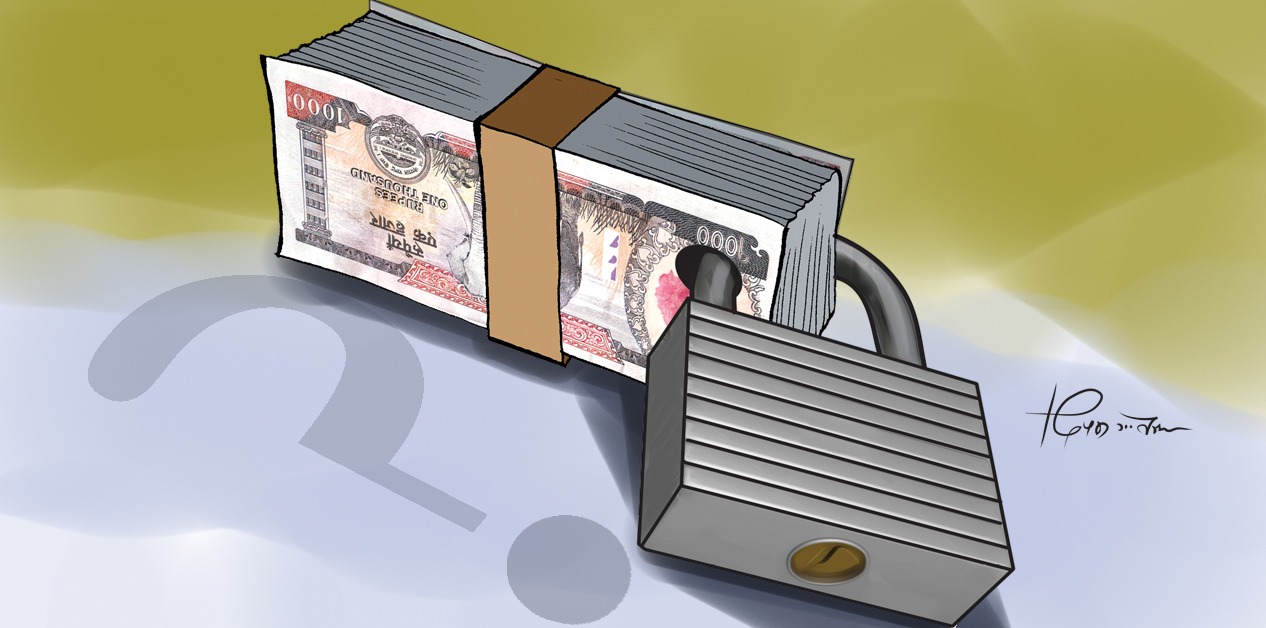
Eases banks and financial institutions to balance credit-to-deposit ratio and make long-term investments.

KATHMANDU: Bhimsen Bohora of Ramechhap has so far opened accounts in 11 banks. However, he currently transacts only through two bank accounts. Teaching at private colleges, he had opened accounts at different banks to receive his salary from different educational institutions. But after using those accounts for some time, they became inactive. Since he did not transact through them, the accounts became inactive.
“I ended up opening accounts in 11 banks,” he says, counting with his fingers. “As I changed institutions during my teaching career, the number of bank accounts also increased. The accounts remained active as long as I worked in the respective institutions and received salary there, but once I left the institutions, the accounts also turned inactive.”
He is not even sure how much money is in which bank account. “There must be two or three hundred rupees in each account. For such a small amount, it doesn’t make sense to go and reactivate those inactive accounts,” said Basnet.
The number of people who open bank accounts and then leave them inactive after going abroad is also significant. Whether for foreign employment or studies, people tend to leave some money in the accounts they had opened before leaving.
Salina Basnet from Sindhupalchok is currently in Australia. While in Nepal, she had opened accounts in seven banks to trade in the stock market. She says there could be around 10,000 rupees in all those accounts combined. “I had accounts in seven banks. There is some money in each of them. Altogether, it must reach around 10,000 rupees,” she said.
Similarly, there are plenty of people who open accounts in various banks and financial institutions, transact for a while, and then leave them inactive. Most people open accounts for some specific purpose, and after leaving the minimum balance, abandon them inactive.
According to data obtained by Nepal News from Nepal Rastra Bank through the Right to Information Act, as of the end of last fiscal year, the number of inactive accounts of ordinary citizens and organizations opened in banks and financial institutions across the country stands at 19,013,413. By the end of last fiscal year, these accounts held an unclaimed balance of Rs 188,350,592,198.
In 2016, the government had announced the ‘one person, one account’ policy to expand access to banking services for all citizens and strictly implemented it through Nepal Rastra Bank. After that, the number of deposit accounts increased. As of the end of last fiscal year, the total number of accounts opened in banks and financial institutions had reached 59,881,353. Meanwhile, according to the 2021 census, Nepal’s total population is only 29,164,578.
The number of people who open bank accounts and then leave them inactive after going abroad is also significant
According to Nepal Rastra Bank’s Executive Director and Spokesperson Kiran Pandit, the large number of accounts in banks and financial institutions may also be due to the tendency of people to open accounts for different purposes and not close them once the purpose is over.
The unified directive issued by Nepal Rastra Bank in 2024 states that if no transactions are made from a current account in a bank or financial institution for one year, such an account must be classified as inactive. The directive says: “If no transactions are made in savings accounts for three years, and in call accounts and current accounts for more than one year, such accounts must be made inactive.”
When updating such accounts, the respective institutions are required to do so according to the customer identification policy. For this, the concerned individual must be physically present at the bank to update their details. In recent times, however, Nepal Rastra Bank has made provisions that accounts can also be updated by identifying customers through electronic means.
How much money is in the inactive accounts of each bank?
A total of 54 banks and financial institutions are operating in Nepal, including 20 commercial banks, 17 development banks, and 17 finance companies. Among them, the highest number of inactive accounts are in commercial banks.
According to the central bank’s data, the five banks with the highest number of inactive accounts are Rastriya Banijya Bank, Global IME, Prabhu, NIC Asia, and Nepal Investment Mega Bank (NIMB). As per the data up to the end of last fiscal year, Rastriya Banijya Bank alone has 1,857,243 inactive accounts. Similarly, Global IME Bank has 1,808,543, Prabhu Bank has 1,386,072, NIC Asia has 1,296,011, and NIMB has 1,111,283 inactive accounts.
Among the inactive accounts, the highest amount of money is held at Nepal Bank. In the country’s oldest bank, the inactive accounts contain Rs 23,475,591,664.
In Nabil Bank, which has foreign investment, the inactive accounts hold Rs 14,151,686,000. Agricultural Development Bank also falls among the banks with a large amount of money in inactive accounts. In that bank, the inactive accounts show Rs 10,070,220,000.
Among development banks, Muktinath Development Bank has the highest amount in inactive accounts. The inactive accounts of that bank contain Rs 7,423,220,000. Similarly, the inactive accounts of Jyoti Development Bank hold Rs 5,901,200,000.
According to the central bank’s data, the five banks with the highest number of inactive accounts are Rastriya Banijya Bank, Global IME, Prabhu, NIC Asia, and Nepal Investment Mega Bank (NIMB).
Among financial institutions, ICFC Finance has the highest amount in inactive accounts, with Rs 1,108,000,000. The inactive accounts of Central Finance contain Rs 493,000,000.
Why do accounts become inactive?
Experts in the banking sector say that the rise in the number of inactive accounts in banks and financial institutions is due to reasons such as one person opening accounts in many institutions, many people going abroad, and the accounts of deceased individuals not being closed.
Former CEO of Global IME Bank, Ratna Raj Bajracharya, says, “Individuals have opened accounts in many banks. Many account holders have gone abroad, and since their accounts are not updated, the number of inactive accounts has increased.” He added that with the rise in the number of inactive accounts, the size of inactive funds has also increased.
At present, local levels (municipalities and rural municipalities) also play a role in increasing inactive accounts in banks. Municipalities carry out development works through consumer committees. To pay for such works, it is mandatory to open accounts in the designated bank in the name of the consumer committee. When opening such accounts, banks require the personal bank accounts of the committee chairperson, secretary, and treasurer. After the consumer committee completes its work, the accounts opened in the names of those officials are not used and become inactive.
If an account holder dies, their account also becomes inactive after the specified period.
Similarly, the accounts of individuals imprisoned due to various legal cases remain inactive. Bank officials say that in cases where a person deposits money in a bank or financial institution without informing family members and later dies, a large amount remains in inactive accounts. In addition, if an account is opened in the name of a company that is no longer active or has shut down, the account remains inactive.
Executive Director Pandit of Nepal Rastra Bank says that under responsible banking practices, if an account becomes inactive, the respective institution is obligated to inform the customer and make it active again. However, banks and financial institutions do not inform customers that their account has become inactive. Instead, only when customers go to the respective bank or financial institution to make transactions do they find out their account is inactive. And to reactivate the account, the institutions create extra hassle by demanding documents such as a copy of citizenship and signature verification.
What happens to the money in inactive accounts?
An account in a bank or financial institution becoming inactive does not mean it is closed. Such an account remains, but no transactions are carried out. The money in such accounts cannot be used by anyone other than the account holder.
If there is some money in an inactive savings or fixed deposit account, interest continues to accumulate regularly. This also contributes to the increase in the size of money in inactive accounts.
Banks are not allowed to use inactive accounts for their own purposes just because they have remained inactive for a long time. Nepal Rastra Bank has made provisions that bank and financial institutions can close accounts with zero balance and no transactions for 10 years by publishing a public notice.
The unified directive issued by the central bank also requires that the details of such closed accounts be posted on the respective bank’s website. In addition, it has been mandated that details of deposit accounts that have not been active and not claimed for 10 years must be submitted to the central bank within the first month of every fiscal year.
Banks and financial institutions are also required to publish a notice in a national daily newspaper once every five years calling on people to claim money from inactive accounts. However, banks and financial institutions have been neglecting this provision.

Nepal Rastra Bank
If no one comes forward to claim the amount in an inactive account for 20 years, and if there is no claim from any party, the deposit amount must be deposited in Nepal Rastra Bank’s “Banking Development Fund,” according to central bank spokesperson Pandit. But so far, no bank or financial institution has deposited money into that fund.
Banking expert Anal Raj Bhattarai says that having large amounts in inactive accounts should be understood as meaning that the liabilities of banks and financial institutions have also significantly increased. “The deposits in banks and financial institutions are liabilities of those institutions, which must be paid at any time. They cannot be counted as assets nor used freely by the institutions,” he says.
However, as the volume of money in inactive accounts increases, it becomes easier for banks and financial institutions to balance their credit-to-deposit ratio. Since depositors do not immediately demand the return of money in inactive accounts, institutions also get the opportunity to invest for the long term.
No matter how long a person’s savings in a bank account remain inactive, that money cannot be used freely by the bank or even by the state. Such provisions exist not only in Nepal but also abroad. In Australia, if an account remains inactive for seven years in any bank, the money must be transferred to the Australian Securities and Investment Commission under the government.
Before transferring the amount to the Commission’s account, however, the bank must attempt to contact its customer. Later, if the concerned person claims their money, the Commission has a procedure in place through which the amount can be returned.
In American banks too, if an account remains inactive for three to five years, the money in it must be transferred to the account of the “Unclaimed Property Division.” The concerned person can claim the money in their account at any time. In such cases, the savings can be returned after completing the prescribed process.
In Nepal as well, if no one comes to claim the money in an inactive account for 20 years, such money must be placed in Nepal Rastra Bank’s “Banking Development Fund.” This amount must be returned if a rightful claimant comes forward.